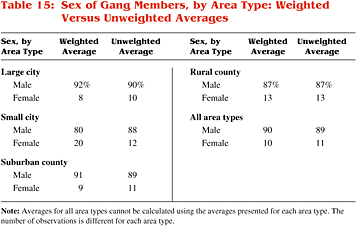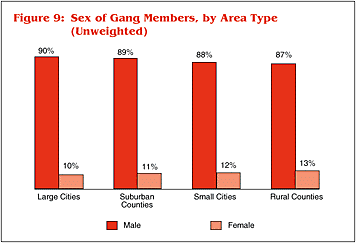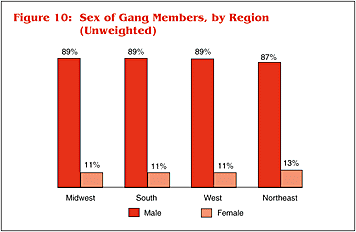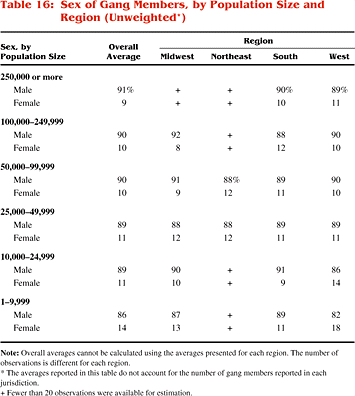|
Nearly all research concludes that males dominate gang membership. Some studies have indicated that females represent less than 10 percent of all gang members, and one recent study estimated the figure as low as 3 or 4 percent (Curry, Ball, and Fox, 1994; Esbensen and Winfree, in press; Miller, 1982). Other studies have reported that the proportion of females in gangs is much larger, ranging from approximately one-fourth to one-third of all gang members in urban adolescent samples.6
Some researchers have argued that law enforcement agencies tend to minimize female gang membership. Curry (1998) suggested that law enforcement might not view female gang involvement as serious enough to be considered a problem. Females were identified as suspects in only 2 percent of 1,346 Los Angeles County gang-related homicides dating back to 1979 (Klein, 1995). In addition, only 2 of 286 gang homicides that occurred in Chicago between 1988 and 1990 were attributed to females (Spergel, 1995).
Agencies responding to the 1996 National Youth Gang Survey reported that, when the number of gang members reported in each jurisdiction was controlled for, females constituted 10 percent of the total. The unweighted responses showed that, on average, females accounted for 11 percent of gang members (see table 15). Differences between weighted and unweighted estimates were fairly minimal, except in small cities.
Figure 9 depicts the sex of gang members by area type, irrespective of the number of gang members reported in each jurisdiction. The average proportion of female gang members was highest in rural counties and lowest in large cities. All of the differences in sex by area type were found to be statistically significant.
Regional variation in the sex of gang members was minimal. The average proportion of female gang members was 13 percent in the Northeast and 11 percent in the Midwest, South, and West (see figure 10). These differences were not statistically significant.
When sex was examined by region and area type, limited variation was evident (see Appendix K). Agencies in rural counties reported that the average proportion of female gang members in the West was 18 percent and in the Midwest, 16 percent. The lowest average proportion of females (9 percent) was reported by agencies in small cities in the Midwest. Little information was available for the Northeast, because of a limited number of observations.
Population size, more than area type and region, appeared to affect the average proportion of male and female gang members. As table 16 illustrates, the average proportion of female gang members reported by respondents decreased as the population of the locality increased. Agencies reported that the average percentage of female gang members was 14 percent in jurisdictions with populations less than 10,000 and 9 percent in jurisdictions with populations greater than 250,000. The average proportion of female gang members reported in the smallest jurisdictions (populations less than 10,000) was highest in the West (18 percent).
The effect of population size on the average proportion of male and female gang members was determined to be statistically significant. Nationally, the average proportion of female gang members decreased as the population increased. Consistent with this overall pattern, the average proportion of female gang members in the smallest population range was higher than the average proportion in the largest population range for the Midwest, South, and West. However, this pattern was not always linear. For example, the average percentage of female gang members reported by jurisdictions in the 10,000-24,999 population range was lower than the average percentage found in the 25,000-49,999 population range in the Midwest and South. Too few observations were available for the Northeast to allow a reliable estimate for the population ranges of 1-9,999, 10,000-24,999, 100,000-249,999, and 250,000 or more.
|



